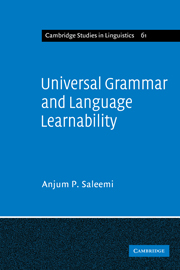Book contents
- Frontmatter
- Contents
- Preface
- 1 The problem of language learnability
- 2 The components of the linguistic system
- 3 The components of the learning system
- 4 Approaches to parameter fixation
- 5 The scope and limits of the current approaches
- 6 The distribution and variety of null subjects
- 7 Augmented parameter fixation: pro subjects and learnability
- 8 Review and integration
- Notes
- References
- Index
2 - The components of the linguistic system
Published online by Cambridge University Press: 04 August 2010
- Frontmatter
- Contents
- Preface
- 1 The problem of language learnability
- 2 The components of the linguistic system
- 3 The components of the learning system
- 4 Approaches to parameter fixation
- 5 The scope and limits of the current approaches
- 6 The distribution and variety of null subjects
- 7 Augmented parameter fixation: pro subjects and learnability
- 8 Review and integration
- Notes
- References
- Index
Summary
This chapter focuses on the major components of Universal Grammar (UG), as conceived within the theory of principles-and-parameters. In addition to providing the general linguistic background, it describes the theory with an eye to those aspects of syntax which are particularly relevant to the present study. The theory comprises a lexical-categorial base, a set of connected levels of representation, various interpretive conventions and mechanisms, and a number of interacting subtheories constraining the overall system.
Projection and interpretation
The base projects lexical and categorial properties uniformly onto the representational levels, namely the syntactic levels of D-structure and S-structure, and the interpretive levels known as PF (phonological form) and LF (logical form). The lexicon contains items classifiable into two types of categories, lexical categories and functional categories. The former include A, N, V, and P, whereas the set of functional categories consists of Comp(lementizer) or C (head of CP = S′), Infl(ection) or I (head of IP = S), and Det(erminer); under some recent accounts (e.g. Chomsky 1989, Pollock 1989), T(ense), Agr(eement), and Neg (i.e. the negative particle) are further recognized as replacements for or additions to such categories.
Lexical items, particularly those belonging to major lexical categories, are associated with subcategorial frames depicting their S(emantic)-selection and C(ategorial)-selection properties (Grimshaw 1979, Pesetsky 1982). Syntactically active semantic properties of selecting elements are embodied in their θ-grids (Higginbotham 1985, Stowell 1981), i.e. the set of thematic (or θ-) roles they can assign.
- Type
- Chapter
- Information
- Universal Grammar and Language Learnability , pp. 15 - 29Publisher: Cambridge University PressPrint publication year: 1992



